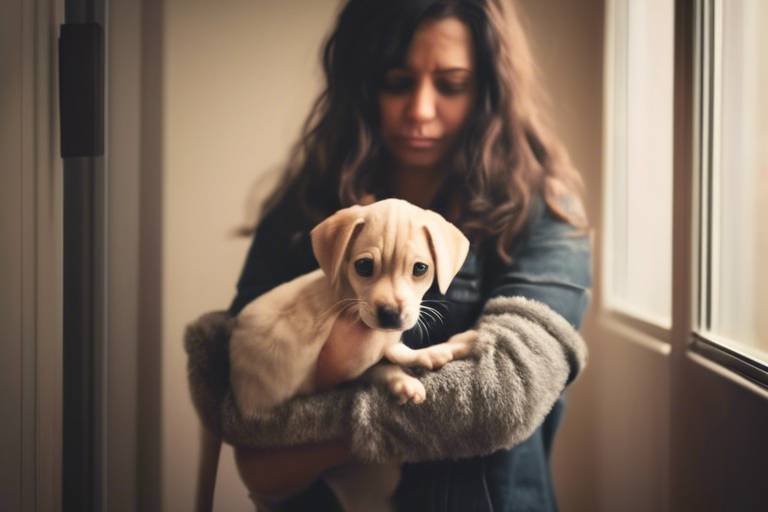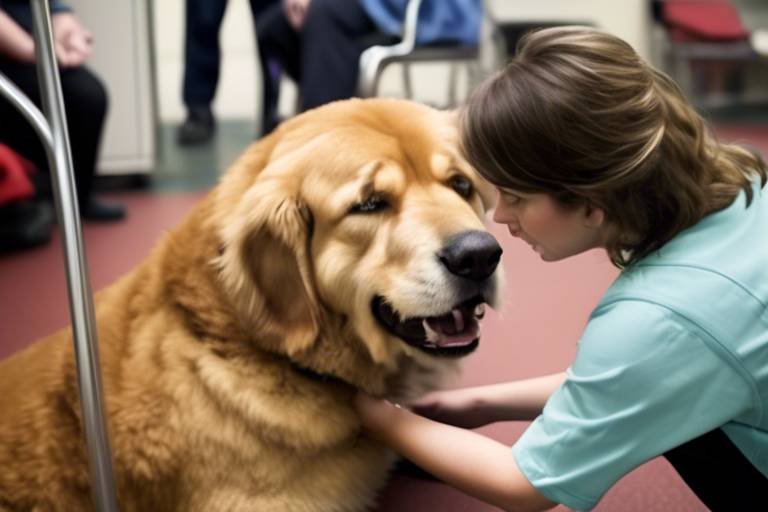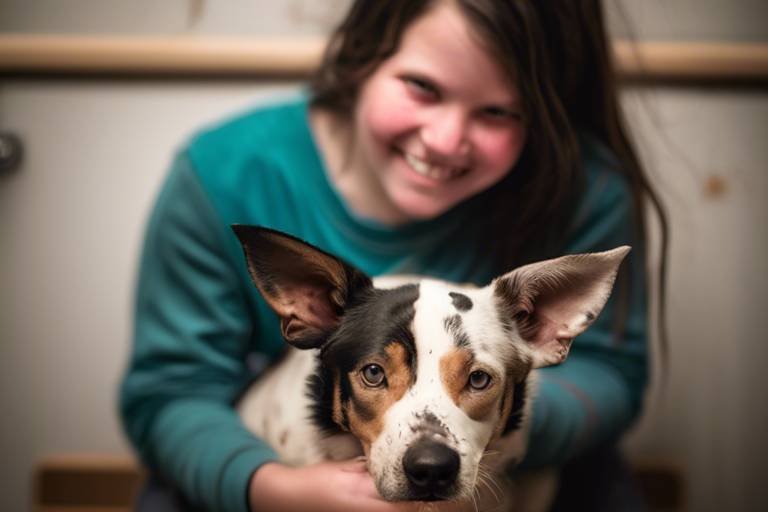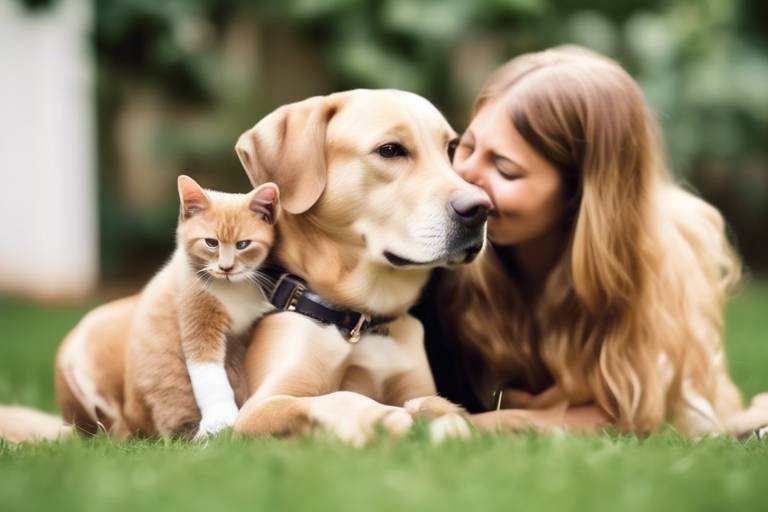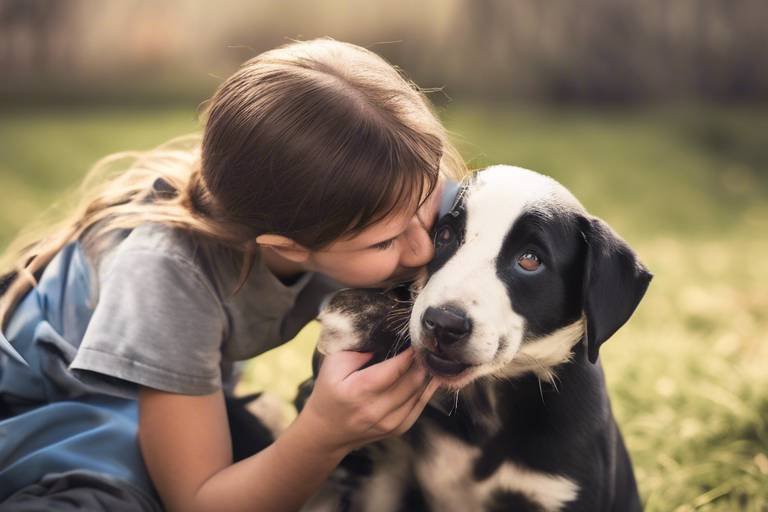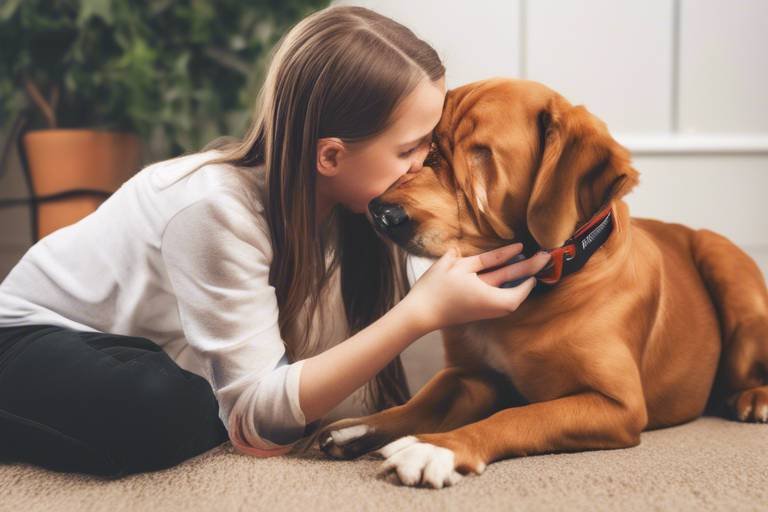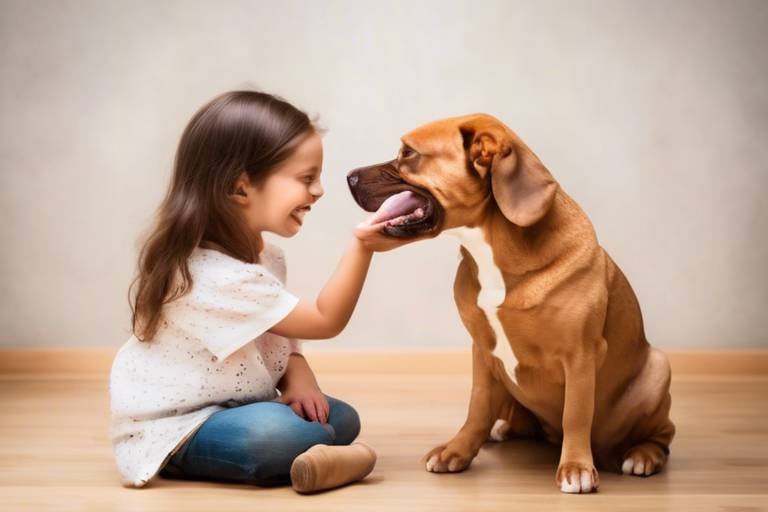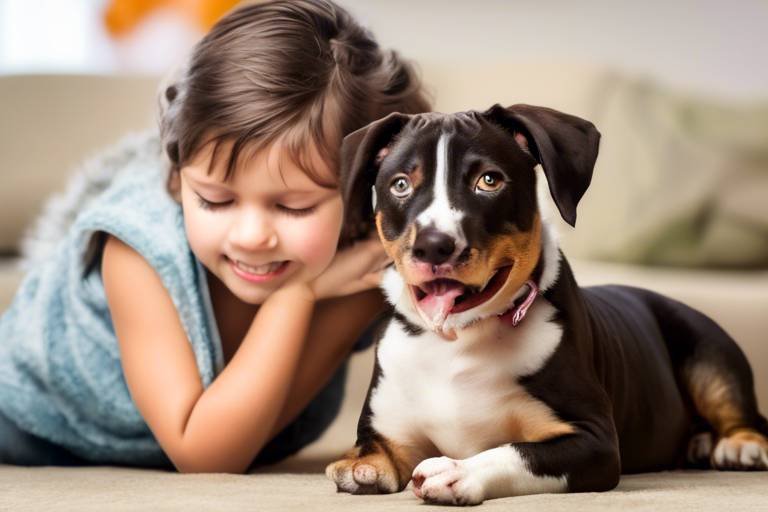How to Help Your Rescue Pet Overcome Separation Anxiety
Bringing a rescue pet into your home is like opening a new chapter in your life, filled with unconditional love and companionship. However, many rescue animals come with their own set of challenges, and one of the most common issues is separation anxiety. This emotional struggle can manifest in various ways, making it essential for pet owners to understand how to help their furry friends feel secure and loved. In this article, we'll explore effective strategies to ease your rescue pet's anxiety, ensuring they thrive in their new environment.
Separation anxiety is not just a quirky behavior; it’s a serious emotional condition that affects many rescue pets, especially those who have experienced abandonment or trauma. When a pet feels anxious about being left alone, it can lead to a range of distressing behaviors. Common causes include a sudden change in environment, lack of socialization, or previous experiences of being neglected. The emotional toll on your pet can be profound, leading to feelings of fear, loneliness, and confusion. Understanding this condition is the first step toward helping your pet feel more secure.
Identifying the signs of separation anxiety early on is crucial for effective intervention. If your pet exhibits certain behaviors when you leave, they might be struggling more than you realize. Some common signs include:
- Destructive Behavior: Chewing on furniture, scratching doors, or digging can all indicate anxiety.
- Excessive Vocalization: Barking, whining, or howling when you leave can signal distress.
- Inappropriate Elimination: Accidents in the house, even if they are potty trained, can be a sign of anxiety.
- Restlessness: Pacing or an inability to settle down may indicate your pet is feeling anxious.
Destructive behavior is often the most visible sign of separation anxiety. When your pet chews on furniture or scratches at doors, they are likely expressing their distress. To address this behavior, it’s important to redirect their energy positively. Providing ample exercise and mental stimulation can help keep your pet occupied. Consider engaging them with interactive toys or puzzle feeders that challenge their minds while you’re away.
Implementing preventive measures can significantly reduce the likelihood of destructive behavior. Start by creating a dedicated safe space for your pet. This area should be comfortable and filled with their favorite toys and blankets. A cozy corner can serve as their sanctuary, where they feel secure even when you’re not home. Additionally, consider using baby gates to limit their access to areas where they might cause damage.
Using positive reinforcement is one of the most effective ways to modify your pet's behavior. When your pet remains calm during your absence, reward them with treats or praise. This will help them associate your departures with positive experiences. Training sessions that focus on calm behavior can also be beneficial. Gradually increase the duration of your absences while providing rewards for good behavior, creating a sense of security for your pet.
Excessive vocalization is another common symptom of separation anxiety. If your pet barks or whines persistently when you leave, it’s important to address this behavior before it becomes a habit. One effective strategy is to desensitize your pet to your departures. Start with short absences, gradually increasing the time you’re away. During this process, try to ignore the vocalizations, as responding can reinforce the behavior.
Establishing a safe and comfortable environment for your pet is crucial in alleviating anxiety. This space should be free from distractions and equipped with items that provide comfort. A cozy bed, favorite toys, and even your worn clothing can help your pet feel more secure. The goal is to create an oasis where your pet can relax and feel at ease, even when you’re not around.
Comfort items can significantly soothe anxious pets. Consider providing plush toys or blankets that carry your scent. These familiar smells can provide a sense of security, helping to calm your pet during your absence. Additionally, there are various anxiety-reducing products available, such as calming collars or pheromone diffusers, which can also be beneficial in creating a serene environment.
Gradual desensitization is a highly effective method for easing separation anxiety. This technique involves slowly acclimating your pet to being alone. Start by leaving your pet alone for just a few minutes and gradually increase this time as they become more comfortable. This process helps your pet learn that you will always return, reducing their anxiety over time.
Q: How long does it take for a rescue pet to overcome separation anxiety?
A: The time it takes varies by individual pet. Some may adjust within weeks, while others may require months of consistent training and support.
Q: Can medication help with separation anxiety?
A: In some cases, veterinarians may prescribe medication to help manage severe anxiety. It's best to consult with a professional to explore this option.
Q: Are there specific breeds more prone to separation anxiety?
A: While any pet can experience separation anxiety, some breeds, particularly those that are more social or have a history of abandonment, may be more susceptible.

Understanding Separation Anxiety
Separation anxiety is a common issue that many rescue pets face when they transition into new homes. It can be heart-wrenching to witness your furry friend struggle with feelings of fear and abandonment. But what exactly causes this anxiety? Typically, it stems from a traumatic past, such as being abandoned, abused, or experiencing frequent changes in their environment. These experiences can lead to a deep-seated fear of being left alone, making it essential for pet owners to understand the emotional and behavioral impacts of separation anxiety.
When a pet suffers from separation anxiety, they may exhibit a range of symptoms that can be distressing for both the animal and the owner. Common emotional signs include excessive clinginess, restlessness, and signs of panic when their human prepares to leave. Behaviorally, pets may engage in destructive actions, such as chewing furniture or scratching at doors, in an attempt to express their distress. Understanding these signs is crucial for providing the right support and intervention.
To illustrate the impact of separation anxiety, consider this: Imagine being in a new environment where everything feels unfamiliar, and the people you trust suddenly leave you alone. This feeling of isolation can be overwhelming for pets, leading to a cycle of anxiety that can be hard to break. By recognizing the signs and understanding the underlying causes, pet owners can take proactive steps to help their furry companions feel secure and loved.
Here are some key aspects to consider when dealing with separation anxiety:
- Emotional toll: Pets with separation anxiety often feel abandoned and scared, impacting their overall well-being.
- Behavioral manifestations: Destructive behavior is a cry for help, indicating that your pet is struggling.
- Need for patience: Overcoming separation anxiety is a process that requires time, understanding, and consistent effort.
Ultimately, helping your rescue pet overcome separation anxiety is about building trust and security in their new environment. By being attentive to their needs and employing effective strategies, you can transform their experience from one of fear to one of comfort and love.

Recognizing the Signs
Recognizing the signs of separation anxiety in your rescue pet is crucial for timely intervention. Just like humans can experience anxiety when faced with separation from loved ones, our furry friends can feel the same way. Imagine being left alone in a big house, feeling uncertain and scared; that’s how your pet might feel when you leave. The sooner you identify these signs, the better equipped you’ll be to help your pet feel secure and loved.
Common behaviors indicative of separation anxiety can range from mild to severe. For instance, some pets might simply sit by the door, waiting for your return, while others could display more extreme reactions. It's essential to observe your pet closely, especially during those moments when you prepare to leave. You might notice them becoming overly clingy, following you from room to room, or even acting out when they sense you’re about to step out.
Here are some of the most typical signs to watch for:
- Destructive Behavior: This often manifests as chewing on furniture, scratching at doors, or digging at carpets. It’s as if they’re trying to express their distress by tearing apart their surroundings.
- Excessive Barking or Whining: If your pet barks or whines incessantly when you leave, it’s a clear sign of anxiety. They might be trying to call you back or express their discomfort.
- House Soiling: Sometimes, pets with separation anxiety may urinate or defecate inside the house, despite being house-trained. This behavior often stems from stress rather than a lack of training.
- Pacing or Restlessness: If you notice your pet pacing back and forth or appearing restless when you’re about to leave, it’s a strong indicator that they are feeling anxious.
- Excessive Licking or Chewing: Some pets may turn to self-soothing behaviors, such as licking their paws or chewing at their skin, which can lead to further issues like hot spots or infections.
Understanding these signs is just the first step. It’s essential to remember that each pet is unique, and their reactions may vary. If you suspect your rescue pet is experiencing separation anxiety, don’t hesitate to consult with a veterinarian or a professional animal behaviorist. They can provide tailored advice and strategies to help your furry friend cope with their anxiety effectively.
Q: How long does separation anxiety last in rescue pets?
A: The duration can vary widely depending on the individual pet and the strategies implemented. With consistent training and support, many pets show improvement within a few weeks to several months.
Q: Can I use medication to help my pet with separation anxiety?
A: In some cases, veterinarians may prescribe medication to help manage anxiety. However, it’s essential to combine medication with behavioral training for the best results.
Q: Is separation anxiety common in all rescue pets?
A: While not all rescue pets experience separation anxiety, it is quite common, especially for those who have faced trauma or abandonment in their past.
Q: What are some immediate steps I can take if I notice signs of anxiety?
A: Start by creating a safe space for your pet, using comfort items, and gradually desensitizing them to your departures. Consistency is key!
Destructive Behavior
Destructive behavior in pets, particularly those rescued from shelters, can be a heart-wrenching sight. If your furry friend is chewing on your favorite shoes or scratching at the door like a little tornado, it’s likely a sign of separation anxiety. This behavior stems from their deep-seated fear of being left alone, and it’s important to approach the situation with understanding and compassion. Just like a child might throw a tantrum when separated from a parent, your pet might resort to these actions as a way of expressing their distress.
First, let’s talk about why pets engage in destructive behavior. When left alone, they may feel a mix of fear, loneliness, and frustration. This emotional cocktail can lead them to chew on furniture, dig into carpets, or even knock over plants. It’s their way of coping with the overwhelming feelings of abandonment. It’s crucial to recognize that this behavior is not a reflection of your pet’s character but rather a response to their circumstances.
To help your pet overcome this destructive behavior, you can implement several strategies:
- Provide Plenty of Exercise: A tired pet is a happy pet! Regular physical activity can help reduce anxiety levels. Aim for long walks, playtime, or even agility training to keep your pet engaged.
- Redirect Their Energy: Offer chew toys or puzzle feeders that can keep your pet occupied. This not only distracts them from destructive behavior but also provides mental stimulation.
- Establish a Routine: Pets thrive on routine. By creating a consistent schedule for feeding, walks, and playtime, your pet will feel more secure and less anxious when you leave.
Additionally, if the destructive behavior persists, you may want to consider consulting with a professional trainer or a veterinarian. They can provide tailored advice and, if necessary, suggest behavioral therapy or medication to help your pet cope better with their anxiety.
Remember, addressing destructive behavior takes time and patience. It’s important to celebrate small victories along the way. Every time your pet chooses a toy over your shoe, it’s a step in the right direction! With love, understanding, and the right strategies, you can help your rescue pet feel more secure and less anxious when you’re not home.
Q: How long does it take for a rescue pet to overcome separation anxiety?
A: The time varies for each pet. Some may improve in a few weeks, while others might take several months. Consistency and patience are key.
Q: Can medication help my pet with separation anxiety?
A: Yes, in some cases, veterinarians may prescribe medication to help manage anxiety. This is often combined with behavioral training for best results.
Q: What are some signs that my pet is experiencing separation anxiety?
A: Common signs include excessive barking or whining, destructive behavior, pacing, and attempts to escape. If you notice these behaviors, it’s essential to take action.
Q: Should I punish my pet for destructive behavior?
A: No, punishment can exacerbate anxiety and lead to more destructive behavior. Instead, focus on positive reinforcement and redirecting their energy.
Preventive Measures
Preventing separation anxiety in your rescue pet is all about creating a nurturing environment that fosters security and comfort. Just like a child who feels safe in their room, your pet needs a space that they can call their own, where they feel protected and loved. Start by designating a specific area in your home that is cozy and free from distractions. This could be a corner of a room with their bed, some toys, and perhaps a blanket that carries your scent. Imagine how comforting it is to curl up in your favorite spot with familiar items around you; your pet feels the same way!
Additionally, consider implementing a routine that helps your pet understand when you're going to be home and when you’ll be away. Pets thrive on consistency, and having a daily schedule can significantly reduce anxiety. For instance, if you always leave at the same time each day, your pet will start to anticipate your departures and learn that you will come back. You might even create a visual schedule using simple graphics that represent different times of the day to help them recognize what’s coming next. This can be especially helpful for dogs that respond well to visual cues.
Moreover, engaging in regular exercise is crucial. A tired pet is a happy pet! Make sure to dedicate time each day to walk, play, and explore with your furry friend. This not only helps to expend excess energy but also strengthens the bond between you two. Think of it as a workout session; the more you exercise, the better you feel! If your pet is well-exercised, they are less likely to develop destructive behaviors when left alone.
Finally, consider using preventive training techniques. Start by leaving your pet alone for short periods and gradually increase the time as they become more comfortable. This method, known as gradual desensitization, helps your pet build confidence in being alone. You can also use positive reinforcement during this training process; reward your pet with treats or praise when they remain calm during your absence. It’s like giving them a little pat on the back for being brave!
In summary, by creating a safe space, establishing a routine, ensuring regular exercise, and implementing preventive training, you can significantly reduce the likelihood of separation anxiety in your rescue pet. Remember, it’s all about making them feel secure and loved in their new environment. With a little patience and effort, you can help your furry friend thrive!
Positive Reinforcement Techniques
When it comes to helping our furry friends overcome separation anxiety, positive reinforcement is like a magic wand. Instead of focusing on what your pet is doing wrong, why not shine a spotlight on what they do right? This technique encourages good behavior by rewarding your pet when they remain calm and relaxed during your absence. Imagine a kid getting a gold star for doing their homework; it’s the same concept! By celebrating their successes, you’re not just boosting their confidence; you’re also building a stronger bond between you and your pet.
So, how do you implement these positive reinforcement techniques effectively? First, you need to identify what your pet values most. Is it a tasty treat, a favorite toy, or perhaps some quality cuddle time? Once you know what makes their tail wag, you can start using it as a reward. For example, when you leave the house and your pet stays calm, reward them with a tasty treat as soon as you return. This creates a positive association with your absence.
Consistency is key here. Just like learning to ride a bike, your pet needs repeated practice to get it right. Start with short departures, maybe just a few minutes, and gradually increase the time as they become more comfortable. Each time you come back to a calm pet, shower them with praise and rewards. This will help them understand that being alone isn’t something to fear.
Another effective method is to incorporate training sessions into your daily routine. Teach your pet basic commands like “sit,” “stay,” or “down.” When they obey these commands, reward them immediately. This not only reinforces their training but also helps to distract them from the anxiety of being alone. Think of it as a mental workout; it keeps their minds engaged and reduces the likelihood of anxious behaviors.
Sometimes, pets can become anxious even before you leave. To combat this, try a technique called counter-conditioning. This involves changing your pet's emotional response to your departure. For instance, you can create a positive routine before you leave, such as giving them a special toy or treat that they only get when you leave. Over time, they’ll associate your departures with something enjoyable, rather than something to stress over.
Lastly, don’t forget to be patient. Just like humans, pets have their own pace for learning and adapting. Celebrate the small victories along the way. If your pet manages to stay calm for just a few minutes longer than last time, that’s progress! With love, patience, and positive reinforcement, you can help your rescue pet feel secure and loved, even in your absence.
- What is positive reinforcement? Positive reinforcement is a training technique that rewards desired behaviors to encourage their repetition.
- How long does it take for my pet to overcome separation anxiety? Every pet is different. Some may take weeks, while others might need months. Consistency and patience are crucial.
- Can I use negative reinforcement to correct behavior? It’s generally not recommended. Negative reinforcement can increase anxiety and worsen the problem.
- What if my pet doesn’t respond to positive reinforcement? Consult a veterinarian or a professional trainer for personalized strategies.
Excessive Barking or Whining
Excessive barking or whining can be a heart-wrenching sound for pet owners, often signaling that your furry friend is struggling with separation anxiety. Imagine your beloved pet, once so full of joy, now expressing their distress through relentless vocalizations every time you leave the house. It's not just noise; it's their way of communicating their unease and longing for your presence. Understanding the reasons behind this behavior is the first step toward helping your pet feel more secure.
When a rescue pet experiences separation anxiety, their vocalizations can become a cry for help. This behavior often stems from a deep-seated fear of abandonment, especially if they have experienced neglect or instability in their past. It’s crucial to recognize that this is not just a phase; it’s a genuine emotional response. The good news is that there are effective strategies to help manage and reduce excessive barking or whining, allowing both you and your pet to enjoy a more peaceful environment.
One effective approach to curbing excessive vocalization involves distraction techniques. Engaging your pet with interactive toys or puzzle feeders can keep their mind occupied while you’re away. This not only distracts them but also provides mental stimulation, which can be incredibly beneficial for anxious pets. Consider setting up a routine where you leave these toys out for your pet to explore as you prepare to leave. This creates a positive association with your departure.
Another method to consider is desensitization. This involves gradually getting your pet accustomed to being alone for short periods. Start by leaving your pet alone for just a few minutes, then gradually increase the duration. During this process, it's essential to remain calm and not make a big fuss when you leave or return home. This helps your pet understand that your departures are normal and nothing to be anxious about.
Additionally, using soothing sounds can create a calming atmosphere for your pet. Soft music or white noise machines can help drown out external noises that might trigger barking. You can also try leaving the television on with calming programs or nature sounds. These auditory distractions can provide comfort and reduce feelings of isolation.
Lastly, if your pet's excessive barking or whining continues despite your efforts, consulting with a veterinarian or a professional animal behaviorist may be beneficial. They can provide tailored advice and, if necessary, discuss potential behavioral therapies or medications that can help alleviate your pet's anxiety. Remember, addressing separation anxiety is a journey, and every small step counts toward creating a more secure environment for your furry friend.
- What are the common causes of separation anxiety in rescue pets?
Separation anxiety can stem from past traumas, changes in environment, or lack of socialization. - How long does it take for a pet to overcome separation anxiety?
The timeline varies; some pets may improve within weeks, while others may take months. - Are there specific breeds more prone to separation anxiety?
Yes, certain breeds, such as Labrador Retrievers and Dachshunds, are known to be more prone to anxiety issues. - Can training help with separation anxiety?
Absolutely! Consistent training and positive reinforcement can significantly reduce anxiety symptoms.

Creating a Safe Space
Establishing a safe and comfortable environment for your rescue pet is essential in alleviating their separation anxiety. Think of it as creating a cozy nook where they can retreat and feel secure when the world feels overwhelming. Just like we all have our favorite spots in the house where we can unwind, your pet needs a designated area that is their own. This space should be free from chaos and disruptions, allowing them to relax and recharge.
When setting up this safe haven, consider the following elements:
- Location: Choose a quiet corner of your home, away from the hustle and bustle. Ideally, it should be a place where they can observe the household activity without feeling stressed.
- Comfort: Provide soft bedding or a favorite blanket to create a warm and inviting atmosphere. Remember, pets love to snuggle just like we do!
- Accessibility: Make sure their safe space is easily accessible, allowing them to retreat there whenever they feel the need.
In addition to these elements, consider using a pet gate to create a defined area. This can help your furry friend feel more secure, knowing they have a space that is just for them. You might also want to include their favorite toys or a puzzle feeder to keep them engaged while you’re away. Just imagine how comforting it must be for them to have a treasure trove of goodies right at their fingertips!
Moreover, it’s crucial to ensure that this space is free from any hazards. Take the time to remove any items that could pose a risk, such as electrical cords or small objects that could be swallowed. Think of it as baby-proofing your home, but for your four-legged friend. A little precaution can go a long way in preventing accidents and ensuring their safety.
Finally, don’t underestimate the power of your scent. Leaving behind a piece of clothing that carries your smell can provide immense comfort to your pet. It’s like a warm hug they can curl up with when you’re not around. Pair that with some soft music or a calming pheromone diffuser, and you’ll create an environment that feels just like home, even in your absence.
By taking these steps to create a safe space, you are not just providing a physical area but also a sanctuary for your pet’s emotional well-being. Remember, the goal is to help them feel secure and loved, which can significantly reduce their anxiety levels over time.
| Question | Answer |
|---|---|
| What are the signs that my pet is anxious? | Common signs include excessive barking, destructive behavior, and attempts to escape. |
| How long does it take for a rescue pet to adjust? | Adjustment periods can vary, but patience and consistency are key. It may take weeks or even months. |
| Can I use calming products for my pet? | Yes, products like calming collars, sprays, and diffusers can help ease anxiety. |
| Should I consult a vet for severe anxiety? | Absolutely! A veterinarian can offer guidance and may recommend behavioral therapy or medication. |
Using Comfort Items
When it comes to easing your rescue pet's separation anxiety, comfort items can play a pivotal role in creating a sense of security and calm. Think of these items as the furry equivalent of a favorite blanket or a cherished toy that a child clings to during tough times. Comfort items can help your pet feel less alone and more at ease when you have to step out. But what exactly qualifies as a comfort item? Well, there are several options to consider, each with its unique benefits.
First and foremost, soft toys can provide a sense of companionship. Many pets find solace in cuddling with a plush toy, which can mimic the warmth and presence of their owner. Look for toys that are durable and safe for your pet to chew on, as they may also help alleviate stress through play. Additionally, consider adding a blanket or a piece of your clothing to their space. The familiar scent can be incredibly soothing, reminding them of your presence even when you're not around.
Another effective option is to use interactive toys that engage your pet's mind. These toys can keep them occupied and distracted during your absence, reducing feelings of anxiety. For example, puzzle toys that dispense treats can serve as both a mental challenge and a reward, making the time spent alone feel less daunting. You can also explore calming products such as pheromone diffusers or sprays, which can create a tranquil atmosphere in your home.
It's essential to observe your pet's reactions to different comfort items. What works wonders for one pet might not have the same effect on another. Therefore, consider creating a comfort zone where your pet can access their favorite items easily. This could be a cozy corner with their bed, toys, and a few comforting scents. By providing a designated area, you create a safe haven that your pet can retreat to when feeling anxious.
In summary, using comfort items is a simple yet effective strategy to help your rescue pet cope with separation anxiety. By incorporating soft toys, familiar scents, interactive playthings, and calming products, you can create an environment that promotes relaxation and security. Remember, the goal is to make your pet feel loved and safe, even when you're not physically present.
- What types of comfort items are best for pets with separation anxiety?
Soft toys, blankets with your scent, interactive toys, and calming pheromone products are all great options. - How can I tell if my pet is comforted by a particular item?
Observe their behavior. If they cuddle, play, or seem more relaxed with the item, it’s likely providing comfort. - Can comfort items completely eliminate separation anxiety?
While they can help, comfort items are usually part of a broader strategy that may include training and behavior modification.
Gradual Desensitization
Gradual desensitization is a powerful technique that can help your rescue pet overcome separation anxiety. Imagine it like teaching a child to swim; you wouldn't throw them into the deep end right away, right? Instead, you start in the shallow end, slowly introducing them to deeper waters. Similarly, with your furry friend, the goal is to gradually increase the time they spend alone, helping them adjust to the idea that being alone is perfectly okay.
The process begins with short absences. Start by leaving your pet alone for just a few minutes. This could be as simple as stepping outside to grab the mail or going to the bathroom. When you return, make sure to greet them calmly. This teaches your pet that your departures are temporary and that you always come back. Over time, you can extend the duration of these absences, gradually building up to longer periods. The key here is to ensure that each step feels manageable for your pet, so they don’t become overwhelmed.
During this process, it’s essential to monitor your pet’s reactions. If they seem anxious or distressed, it might be a sign that you’re moving too quickly. Adjust the timeline according to their comfort level. You might find it helpful to keep a journal to track your pet’s progress, noting how long they were left alone and how they reacted upon your return. This can help you identify patterns and make necessary adjustments. Remember, patience is crucial. Just like us, every pet is different, and some may take longer to adapt than others.
In addition to extending the time alone, you can also incorporate various activities that promote calmness during these periods. For example, providing engaging toys or puzzle feeders can keep their minds occupied, making the time apart less stressful. You might also consider using calming music or white noise machines to create a soothing environment. These sounds can mask outside noises that might trigger anxiety and help your pet feel more secure.
As you work through this process, it's important to celebrate small victories. Each time your pet successfully manages a short absence without showing signs of distress, acknowledge it! This can be as simple as giving them a treat or extra affection. Positive reinforcement will encourage them to associate your departures with good things, further reducing their anxiety.
In summary, gradual desensitization is about building your pet’s confidence and comfort level with being alone. By taking small, manageable steps and providing positive experiences, you can help your rescue pet learn that solitude isn’t something to fear. With time, patience, and love, you’ll be on your way to helping them feel secure and happy in their new home.
- How long does gradual desensitization take? The duration varies for each pet. Some may adapt in a few weeks, while others may take several months. It’s important to be patient and adjust the pace based on your pet's comfort level.
- Can I use treats during desensitization? Absolutely! Treats can be a great way to reward your pet for calm behavior during your absences. Just make sure to use healthy options and not overdo it.
- What if my pet shows signs of extreme anxiety? If your pet exhibits severe anxiety, it might be beneficial to consult with a veterinarian or a professional dog trainer who specializes in anxiety issues. They can provide tailored advice and possible treatment options.
Frequently Asked Questions
- What is separation anxiety in pets?
Separation anxiety in pets is a behavioral condition where a pet experiences extreme distress when left alone. This can lead to various emotional and physical symptoms, such as excessive barking, destructive behavior, or even self-harm. Understanding this condition is crucial for helping your rescue pet feel secure in their new home.
- How can I tell if my pet has separation anxiety?
Common signs of separation anxiety include destructive behavior like chewing furniture, excessive barking or whining, and attempts to escape. If your pet seems overly clingy or becomes anxious when you prepare to leave, these may be red flags that they are struggling with being alone.
- What are some effective strategies to help my pet?
Implementing positive reinforcement techniques, creating a safe space, and gradually desensitizing your pet to being alone can be very effective. Using comfort items such as toys or blankets can also help soothe your pet during your absence.
- Can training help with separation anxiety?
Absolutely! Training your pet using positive reinforcement can encourage calm behavior when you leave. Techniques like rewarding your pet for staying calm or practicing short departures can significantly reduce anxiety over time.
- What should I do if my pet exhibits destructive behavior?
If your pet is exhibiting destructive behavior, it’s essential to redirect this behavior positively. Providing them with appropriate toys, ensuring they have a safe space, and engaging them in regular exercise can help alleviate their anxiety and reduce destructive tendencies.
- How long does it take for a pet to overcome separation anxiety?
The time it takes for a pet to overcome separation anxiety varies widely. Some pets may show improvement within a few weeks, while others might take several months. Consistency in training and creating a comfortable environment is key to helping your pet adjust.
- Are there any medications available for separation anxiety?
Yes, in some cases, veterinarians may prescribe medications to help manage severe separation anxiety. However, it’s essential to combine medication with behavioral training for the best results. Always consult with a veterinarian before starting any medication.
- Can I prevent separation anxiety in my pet?
While not all cases of separation anxiety can be prevented, implementing preventive measures such as early socialization, providing a secure environment, and gradually acclimating your pet to being alone can significantly reduce the risk.





